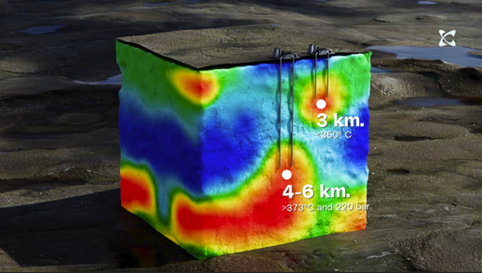First supercritical geothermal site chosen
Published: 24 September, 2025
Land within Rotokawa Geothermal Reservoir in the Taupō Volcanic Zone has been selected as a preferred site for New Zealand’s first supercritical geothermal exploration, with design work already underway to develop the first well.

Conceptual model comparing the targeted ‘supercritical’ conditions to the current conventional geothermal developments.
This early-stage exploration could help prove the viability of supercritical geothermal energy, which has the potential to deliver several times the power output of conventional geothermal wells. This groundbreaking work could be a game changer for securing New Zealand’s future energy needs.
The Rotokawa site was selected following extensive geological and geophysical study by Earth Sciences New Zealand, and risk assessments to confirm its suitability.
Tauhara North No.2 Trust is guardian of the Rotokawa geothermal resources and have deep cultural and historical connection to the area. Its people have used geothermal energy for cooking, bathing, and healing for generations.
A Memorandum of Understanding has been signed between Tauhara North No.2 Trust, the Ministry of Business, Innovation and Employment, and Mercury NZ which operates the Rotokawa geothermal power station, to explore the potential of supercritical geothermal energy at the site. Earth Sciences NZ is contributing technical and scientific expertise.
As part of the work, a multi-disciplinary design team comprising local and international experts, is also being assembled to lead work across regulatory approvals, design, risk assessment, geoscientific modelling, engineering, procurement, drilling and asset management.
The first phases of the project include pre-feasibility work studies, well design, development of a business case and validation of the preferred site. Drilling is expected to begin in 18-24 months.
The Coalition Government has committed up to $60 million from the Regional Infrastructure Fund to support the development of the first well, with plans for two additional wells as part of a broader programme.
Three exploratory wells are the minimum needed to understand the energy resource. New Zealand has pioneered geothermal development in the past with government-led geothermal exploration during 1950s and 1970s. During this time, more than 40 wells were drilled across the motu to explore geothermal resources.
Drilling into supercritical zones means going 1km-3km deeper into the Earth and managing higher pressures and temperatures than current conventional generation. This is one of the most technically demanding frontiers in geothermal technologies and science.
Safely converting and commercialising supercritical geothermal energy is the next step.
The Government is backing this groundbreaking project which aims to unlock transformative, clean, renewable energy over the long term to strengthen the country’s energy security and be transformative for New Zealand and internationally.
Learn more about supercritical geothermal:
Supercritical Geothermal — Geothermal The Next Generation

